Adoptee arrives in the home he doesn’t know
A man who was adopted from South Korea by Americans when he was three years old landed on Thursday in his native country - one that is completely unknown to him - after he was deported from the United States, an official and his lawyer said. U.S. Immigration and Customs Enforcement had ordered Adam Crapser deported because of criminal convictions, including assault and being a felon in possession of a weapon. His life story highlights the failings of an adoption system that put him in the homes of one set of parents who abandoned him and another that physically abused him and other adopted children, his Seattle attorney, Lori Walls, told The Associated Press in a telephone interview.
ICE spokeswoman Rose Richeson told AP in an email that the 41-year-old Crapser arrived in Seoul on Thursday morning aboard a commercial airline flight escorted by ICE deportation officers. Richeson said Crapser was arrested by ICE on Feb. 8 after serving a 60-day sentence for menacing constituting domestic violence and attempted coercion. He had been held in an immigration detention center in Tacoma, Washington since then. A judge could have allowed Crapser to stay in America but decided on deportation. Crapser’s supporters said he waived an appeal because he couldn’t stand the detention center any longer. Walls said she is astonished that the fact that Crapser “was adopted, abandoned and abused ... carried relatively little weight in the decision that the immigration court made.” “The U.S. government facilitated the adoption out of Korea,” she said. “No one followed up to make sure he was safe. When that first family abandoned him to foster care he was not visible - there was no follow-up.”
No one ever sought U.S. citizenship for him. He and his older sister were adopted by a family who lived in Michigan and who later abandoned them after they moved to Oregon, Walls said. Brother and sister were split up. Crapser was eventually adopted by parents in Oregon who assaulted him and other children in their care. His adoptive parents were convicted of multiple crimes. Crapser eventually left the home and was arrested after he broke in to retrieve some of his belongings from his orphanage in South Korea, Walls said. Crapser later got into further trouble with the law. He came under the scrutiny of federal immigration authorities after he applied for a Green Card and they saw his criminal record. “I’m hopeful Adam figures out how to make a life in that country, where he doesn’t speak the language, read the language or know anything about the culture,” Walls said.
His birth mother in South Korea, who had put her son and daughter up for adoption because she couldn’t afford to keep him, is learning English so she can communicate with him when they’re reunited, The New York Times reported recently. “His birth mother, because of publicity in South Korea, came forward,” Walls said, adding that a DNA test proved the relationship. Walls noted that the mother is disabled, has a low income “and can’t be much help for him.” “I spoke with Adam a couple of days ago,” Walls said. “He was trying to stay positive, but I mean it was clear talking to him that he was scared. He’s going to a country where he can’t even read the street signs.” Walls said there might be legal remedies for Crapser to return to the U.S. but that it would be “an uphill battle.”

'Study > English' 카테고리의 다른 글
| Thailand Today (0) | 2016.11.25 |
|---|---|
| China closes door on Korean entertainers (0) | 2016.11.24 |
| Trade agency details 2017 trends: China and green (0) | 2016.11.22 |
| Korean start-ups lacking diversity (0) | 2016.11.21 |
| A Different Kind of Fantasy (0) | 2016.11.18 |
55 Brilliant Advertising Posters With High Impact

'Interesting > Impressive Advertisements' 카테고리의 다른 글
| 55 Brilliant Advertising Posters With High Impact (0) | 2016.11.25 |
|---|---|
| 55 Brilliant Advertising Posters With High Impact (0) | 2016.11.24 |
| 55 Brilliant Advertising Posters With High Impact (0) | 2016.11.22 |
| 55 Brilliant Advertising Posters With High Impact (0) | 2016.11.21 |
| 55 Brilliant Advertising Posters With High Impact (0) | 2016.11.18 |
말 하나, 행동 하나하나가 나를 만든다
우리가 하는 행동 하나, 말 한마디가
모두 우리의 모습을 만든다.
남에게 베푼 친절, 극복한 편견, 이겨낸 어려움,
뿌리친 유혹 하나하나가 우리가 되고픈 사람에
한걸음 더 다가가도록 한다.
- 딘 스탠리 (성공회 신부)

'Interesting > Quote' 카테고리의 다른 글
| 상황을 바꾸려면 자신이 바뀌어야 한다 (0) | 2016.11.25 |
|---|---|
| 실패가 눈앞에 왔을 때가 가장 기뻐해야 할 때다 (0) | 2016.11.24 |
| 지금 바로 희망을 선택하라 (0) | 2016.11.22 |
| 모두가 반대하는 일은 성공한다 (0) | 2016.11.21 |
| 위험을 감수하고 낯설음을 즐겨라 (0) | 2016.11.18 |
たれる: 타레루 (늘어지다 / 내리다)
よだれがたれる。: 침이 늘어지다.
幕(まく)がたれる。: 막이 드리워지다.
ソースがたれてしまった。: 소스를 흘려버렸다.

'Study > Japanese' 카테고리의 다른 글
| うごく (動く): 우고쿠 (움직이다) (0) | 2016.11.24 |
|---|---|
| たく (炊く): 타쿠 ((밥을) 짓다 / 삶다 / 익히다) (0) | 2016.11.23 |
| にく (肉): 니쿠 (고기) (0) | 2016.11.21 |
| かぞえる (数える): 카조에루 (세다) (0) | 2016.11.18 |
| つまらない: 츠마라나이 (재미없다) (0) | 2016.11.17 |
Trade agency details 2017 trends: China and green
The elimination of China’s decades-old “one child” policy is expected to create new opportunities for Korean toy and children’s product makers, while the worldwide emphasis on environmental protection is expected to generate more demand for electric cars and environmentally-friendly buildings, which could benefit Korean manufacturers. These are just some of the strategies and trends outlined in the Korea Trade-Investment Promotion Agency’s annual report for how Korean companies can take advantage of newly emerging opportunities across the world next year, based on data collected from its 33 trade offices in different countries.
The end of China’s population control policy, perhaps the most infamous in the world, in 2015 is expected to be a boon for Korean manufacturers of children’s products, as the younger population of its giant neighbor will grow in coming years. “As the safety of children’s products made in China is dubious after the melamine-tainted powdered milk scandal [in 2008], parents are looking for quality import products,” said Ro Hyun-joo, who works at the Korean trade agency’s Hangzhou office in southeastern China. As China’s third-largest trading partner, Korea has a good chance of banking on the opportunity. Exports of Korean children’s products amounted to $230 million in 2015, a jump of 5.8 times from five years prior, according to data from the Korea Customs Service. “The popularity of Korean pop culture in China and the influence of successful television programs like ‘Dad! Where are We Going?’ [a reality show where children and their fathers go on trips together] may have spurred Chinese interest for Korean child care goods,” Ro said.
Prospects are also good for Korean companies hoping to enter countries like Paraguay, the Philippines and Vietnam, the report said. In particular, Paraguay’s “Maquila Program,” which allows foreign factories to import certain materials and equipment tariff-free and then export finished goods, is a notable business opportunity that could help Korean companies’ entry into Latin American markets. In terms of worldwide trends, the trade agency pointed to increasing demand for environmentally-friendly products, including electric bicycles, vehicles and green buildings. Germany, with its strong automakers, has accelerated development of electric cars. Volkswagen is working toward releasing over 20 electric vehicle models by 2020 and replacing 25 percent of its cars with electric ones.
Korean automakers Hyundai Motor and Kia Motors have released the Ioniq and Niro but they are still in the early stages of development. Korea itself lacks the infrastructure to ramp up development. While there are around 80,000 electric vehicles registered in Korea, the number of fast charging stations nationwide is less than 500 units. Compared to the United States, where there are 6.6 vehicles per charging station, and China, where the number is 3.8, there are a whopping 17 electric vehicles per station in Korea. “Koreans have a competitive edge in battery-making technology and so we expect Korean companies to leap into the electric mobility business in the future,” said Lee Ho-bin, a Korea Trade-Investment Promotion Agency employee in Germany.
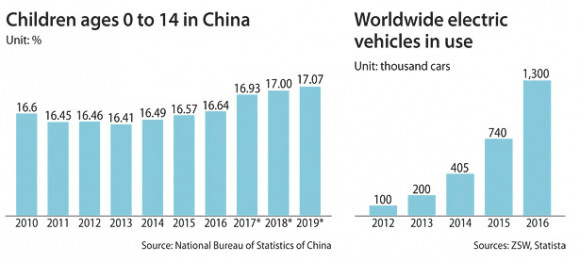
'Study > English' 카테고리의 다른 글
| China closes door on Korean entertainers (0) | 2016.11.24 |
|---|---|
| Adoptee arrives in the home he doesn’t know (0) | 2016.11.23 |
| Korean start-ups lacking diversity (0) | 2016.11.21 |
| A Different Kind of Fantasy (0) | 2016.11.18 |
| Cho secures her first season title at KLPGA (0) | 2016.11.17 |
55 Brilliant Advertising Posters With High Impact

'Interesting > Impressive Advertisements' 카테고리의 다른 글
| 55 Brilliant Advertising Posters With High Impact (0) | 2016.11.24 |
|---|---|
| 55 Brilliant Advertising Posters With High Impact (0) | 2016.11.23 |
| 55 Brilliant Advertising Posters With High Impact (0) | 2016.11.21 |
| 55 Brilliant Advertising Posters With High Impact (0) | 2016.11.18 |
| 55 Brilliant Advertising Posters With High Impact (0) | 2016.11.17 |
지금 바로 희망을 선택하라
활기와 희망도 선택이다.
같은 길을 걸어도 절망을 선택한 사람은
삶의 종착지에서 불행이란 마침표를 찍게 되고,
희망을 선택한 사람은 결국 행복의 산봉우리에 오르게 된다.
‘선택’은 곧 ‘생각’이다.
생각 자체가 희망차야 그 다음 내딛는 발걸음도 희망차게 된다.
지금 바로 희망을 선택하라.
- 오종환, ‘행복할 때 살피고 실패할 때 꿈꿔라’에서

'Interesting > Quote' 카테고리의 다른 글
| 실패가 눈앞에 왔을 때가 가장 기뻐해야 할 때다 (0) | 2016.11.24 |
|---|---|
| 말 하나, 행동 하나하나가 나를 만든다 (0) | 2016.11.23 |
| 모두가 반대하는 일은 성공한다 (0) | 2016.11.21 |
| 위험을 감수하고 낯설음을 즐겨라 (0) | 2016.11.18 |
| 리더는 책임지는 자리이다 (0) | 2016.11.17 |
지하철에서 만나는 철학자들

어떤 언어는 고착화 되고 어떤 언어는 그 쓰임새가 더 확장되는 것 같다. 섹시란 말도 단순하게 여성을 지칭하는 말에서 남성 그리고 전체가 아닌 특정 신체 부분까지 그 영역이 확대되는가 싶더니 이제는 눈으로 볼 수 없는 영역까지 그 쓰임새가 확대된 것 같다. 약간은 어색한 표현인 뇌가 섹시하다는 말은 어떤 말 일까? 아무래도 우리가 흔히 말하는 섹시함과는 다른 의미일것이다. 그리고 아마도 지적인 사람들을 섹시하게 느끼는 데서 온 표현일 수도 있겠다. 아무튼 현대 사회는 외적인 면을 넘어 내적인 면까지 완벽히 섹시한 사람을 원하니 점점 섹시해 지기가 힘들어 지는것 같다. XD
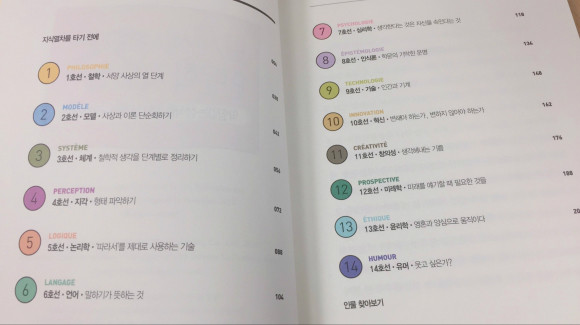
근 현대 철학사에서 빠질수 없는 국가가 바로 독일과 프랑스인데, 이 책의 저자는 프랑스 인으로서 당최 출발과 끝을 낼 수 없는 철학이라는 하나의 복잡한 주제를 어떻게 정리하고 설명할 수 있을지 고심하다 파리의 지하철 노선도를 보고 아이디어를 얻었다고 한다. 지하철 노선을 모방 함으로써 분명 철학자들을 각각의 주제에 부합하는 철학자 들로 구분짓고(1~14호선) 주제가 교차하는 철학자는 각 노선이 환승할 수 있는 환승역에 둠으로써 일반인들이 철학과 철학자들을 이해하는데 좀더 큰 그림을 그려 보는데 도움이 될 것이라 믿었던 저자는 이렇게 떡 하니 인문학 지도를 만들어 냈다. 이렇게 만들어진 노선은 1호선인 철학노선 부터 14호선인 유머노선 까지 흡사 도심의 지하철 처럼 어지러이 엮여져 있다.
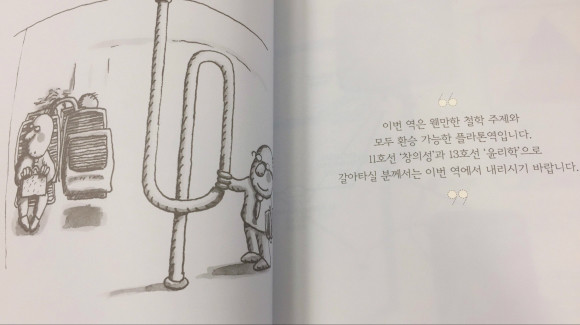
책의 구성은 각 노선의 도입부에 노선을 대표할 만한 특징을 익살스럽게 표현하는데서 시작된다. 원문을 알 수가 없어서 작가의 의도가 반영된 문구인지 궁금하지만 흡사 우리 정서에 맞게 의역 되었다는 생각이 많이드는 문구들을 각 노선의 도입부에서 만날 수 있다. 가령 5호선 논리학의 도입부의 "우리 열차는 논리와 말장난의 간격이 매우 좁습니다. 내리실 때 개념이 빠질 수 있으니 조심하시기 바랍니다."와 같은 재치있는 안내문구가 그렇다. 각 노선의 시작점에서 재치있는 안내 문구를 만나는 것도 이 책의 매력이 아닌가 싶다.
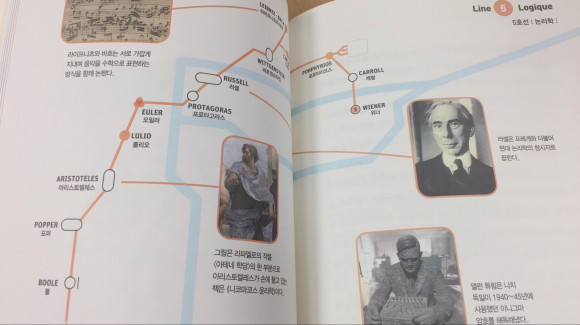
각 노선의 안내문구를 듣고 실제 노선도를 살펴보면 이렇게 노선의 주제에 부합하는 철학자들이 각 역에 포진되어 있는 것을 볼 수 있다. 의도적인지 모르겠지만 저자가 zoom-in 한 철학자들은 우리에게 일반적으로 잘 알려진 철학자들 보다는 조금 생소한 철학자들이 더 많다. 사진속의 앨런 튜링은 철학자 보다는 수학자로 더 알려진 인물이라 생각되는데 그나마 2차 세계대전 당시 독일의 이니그마 암호를 해독하기 위해 현대 컴퓨터의 시초가 된 기계를 만들어 낸 수학자의 이야기를 그린 영화 이미테이션게임으로 우리에게 좀 알려진 듯 하다. 이렇듯 이 책은 반드시 철학자로 규명된 사람들이 아닐 지라도 해당 노선의 주제에 부합되는 역사적 인물이라면 다른 철학자들과 함께 거론되고 있다. 가령 유머 노선의 찰리채플린 같은 경우가 그렇다.
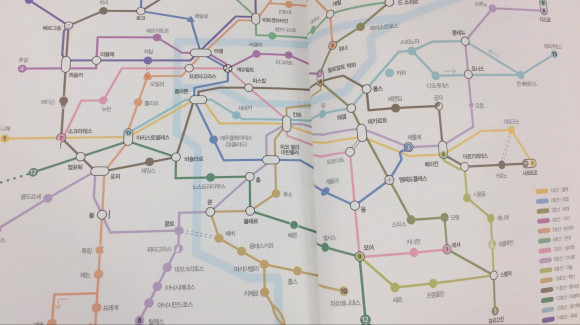
1호선 부터 14호선까지 길다면 길고 짧다면 짧을 수 있는 여정을 마치고 나면 우리가 매일아침 대중교통으로서 마주하는 지하철의 전체 노선도와 같은 정리된 철학 노선을 만날 수 있다. 사실 이 전체 노선만 보면 굉장히 복잡해 보이지만 책의 처음부터 끝까지 잘 따라온 독자 들이라면 꼭 어지럽지 만은 않을 것이다.
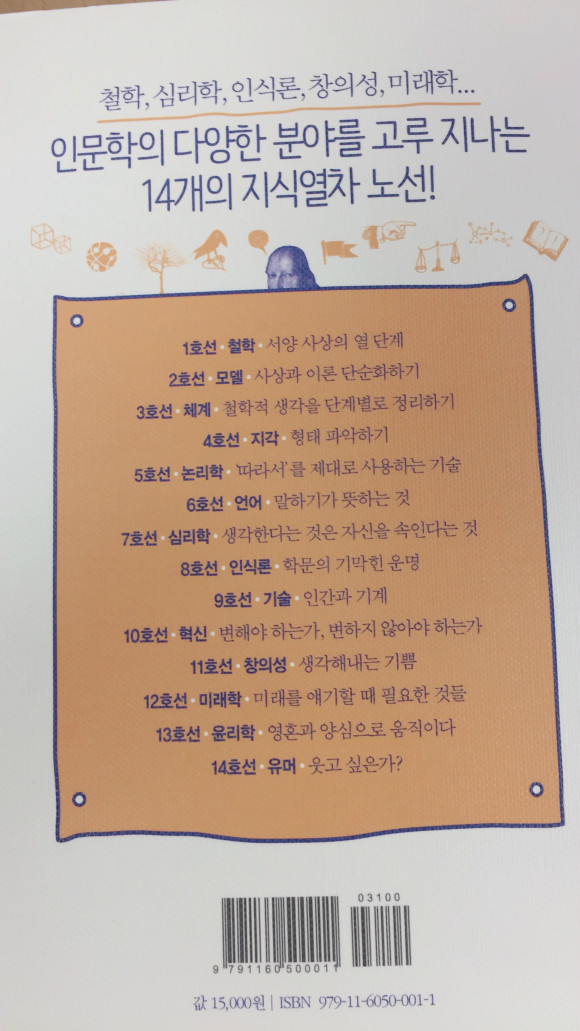
지식열차 노선이라고 하니 왠지 여행을 떠나는 것 같은 흥분이 생긴다. 철학사는 그 유래도 깊지만 각 철학사조의 깊이나 각 철학자들이 평생을 고민했던 주제들인 만큼 한 권의 책으로 그 모든것을 이해하기는 힘들다. 한 철학자에 대해서도 한 권의 책 만으로 깊은 이해를 얻기 힘들기는 마찬가지일 것이다. 하지만 철학의 큰 맥락과 각 철학자들이 어떻게 연결되는지 그리고 각 주제별 철학의 사유가 어떻게 되는지에 대한 큰 그림을 그려보기에 이 만큼 좋은 책이 또 있을까 싶다. 본격적으로 철학에 대한 깊은 지식을 채우기 이전의 예열 단계로 보아도 좋고 어렵고 딱딱한 철학이라는 주제를 우리의 일상에 맞닿아 있는 지하철에 비유하여 접근을 용이하게 해주었다고 생각하는 것도 좋을 것이다. 아무튼 이 책은 무거운 주제를 가벼운 마음으로 재미있게 읽을 수 있는 책 이라고 생각한다.
* 이 리뷰는 예스24 리뷰어클럽을 통해 출판사에서 도서를 제공받아 작성되었습니다.
'My Life > Book' 카테고리의 다른 글
| 살짝 엿보는 사춘기 소녀들의 파티 (0) | 2016.11.28 |
|---|---|
| 1년 = 365일 = 8760시간 (0) | 2016.11.23 |
| EBS방송교육 이제 편하게 mPDF로! (0) | 2016.11.18 |
| 까칠한 고양이가 400일 동안 끄적거린 일기 (0) | 2016.11.17 |
| だめだ: 다메다 (안되다) (0) | 2016.11.15 |
にく (肉): 니쿠 (고기)
肉(にく)が大好(だいす)きです。: 고기를 매우 좋아해요.
豚肉(ぶたにく)より牛肉(ぎゅうにく)の方(ほう)が好(す)きです。: 돼지고기보다 소고기를 좋아해요.
肉(にく)を焼(や)く。: 고기를 굽다.
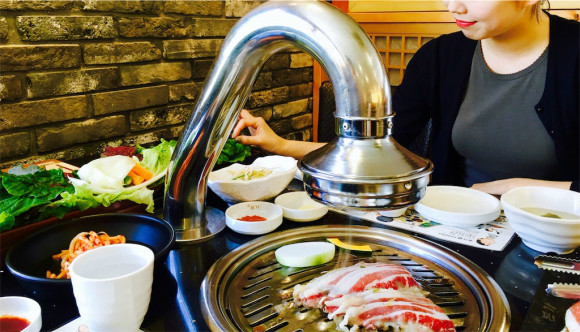
'Study > Japanese' 카테고리의 다른 글
| たく (炊く): 타쿠 ((밥을) 짓다 / 삶다 / 익히다) (0) | 2016.11.23 |
|---|---|
| たれる: 타레루 (늘어지다 / 내리다) (0) | 2016.11.22 |
| かぞえる (数える): 카조에루 (세다) (0) | 2016.11.18 |
| つまらない: 츠마라나이 (재미없다) (0) | 2016.11.17 |
| かくにん (確認): 카쿠닝 (확인) (0) | 2016.11.16 |
Korean start-ups lacking diversity
Korea’s start-up scene lacks diversity in gender and nationality compared to the world’s leading regions for start-ups and innovation, according to a study on Korean start-ups. Women are just 9 percent of start-up founders in Korea, versus 24 percent in Silicon Valley, 20 percent in Tel Aviv and 19 percent in Singapore, according to a white paper released Wednesday by the Korean Startup Ecosystem Forum, a private think tank. Gender imbalance is rampant worldwide, even in Silicon Valley where just 10 percent of founders of so-called high-growth firms are women. But start-ups in Korea hire more women than other cities. Female employees make up 32 percent of Korean start-ups, while just 29 percent in Silicon Valley and 24 percent in London. “Despite low entrepreneurship among women, overall participation of women in Korean start-ups is at a globally competitive level,” said Lee Ji-eun, professor of business information at Hanyang Cyber University and one of the co-authors of the study, at a news conference Wednesday at Google Campus Seoul.
The white paper is based on surveys and interviews with 295 start-ups in Seoul and Gyeonggi. The results were compared with four other technologically advanced regions, or start-up hubs. Foreign participation in the Korean start-up ecosystem is much lower than in the other locations. Whereas London start-ups fill as much as 53 percent of their workforce with non-British nationals, and the percentage in Singapore stands at 52 percent, just 17 percent of Korea’s workforce is foreign. Korean regulations that place a 20 percent cap on the number of international employees in any company and a complicated and difficult visa system limits international diversity, the study says. These factors have been previously noted by countless entrepreneurs and experts who have pointed out that President Park Geun-hye’s administration has set “creative economy” as a key policy imitative but hasn’t eased regulations for foreigners. Investments in Korean start-ups, however, have risen in the past two years. The number of rounds of investments made in start-ups that are less than a year old increased 73 percent to 88 and investments in two- to three-year-old start-ups also rose 81 percent to 62.
“Korea’s start-up ecosystem has grown rapidly in the past four years,” said Hwang Byung-sun, managing director of Big Bang Angels and co-editor of the study. “China and Southeast Asia have been posting growth but Korea doesn’t fall behind. But the excellence of our ecosystem isn’t that much publicized internationally, which led us to publish this white paper.” The study shows that the average start-up entrepreneur in Korea is a man in his 30s who has an engineering degree, is fluent in English and had at least five years’ work experience. More entrepreneurs with degrees at the master’s level or above have joined start-ups this year. The percentage of master’s degree holders is now 25 percent, up from 15 percent two years ago, and those with doctorate degrees more than tripled to 10 percent in the same time frame. In Silicon Valley, the percentage of master’s degree holders was 30 percent and doctorate degree holders was 10 percent in 2014, the latest year data was available for. The cost of launching a start-up in Korea is $27,000 and the number of starting members is 2.78 on average. It takes about four years for a start-up to receive a Series A investment, or the first round of venture capital financing.
By region within Seoul and Gyeonggi, Gangnam in southern Seoul, accommodated the largest portion of start-ups at 39 percent, followed by Seongnam in Gyeonggi at 22 percent. “Gangnam is where the investment and networking are,” said Back Sang-hoon, professor of digital media at Kyungsung University and one of the study’s co-authors. “Over 3,000 start-up related events take place a year and 81 percent of all venture capital firms are located in Gangnam."
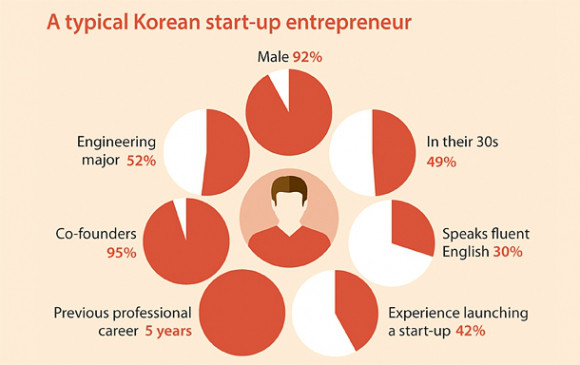
'Study > English' 카테고리의 다른 글
| Adoptee arrives in the home he doesn’t know (0) | 2016.11.23 |
|---|---|
| Trade agency details 2017 trends: China and green (0) | 2016.11.22 |
| A Different Kind of Fantasy (0) | 2016.11.18 |
| Cho secures her first season title at KLPGA (0) | 2016.11.17 |
| Trump affirms U.S.-Korea alliance (0) | 2016.11.16 |




 이 책은 무거운 주제를 가벼운 마음으로 재미있게 읽을 수 있는 책 이라고 생각한다.
이 책은 무거운 주제를 가벼운 마음으로 재미있게 읽을 수 있는 책 이라고 생각한다.